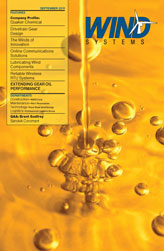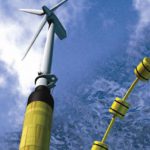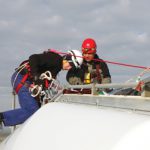Wireless technology was once limited by inadequate bandwidth, early integrated circuit design, and insufficient power management technology. Improvements to today’s wireless networks allow robust monitoring and control, even in remote and harsh applications or classified areas.
Bidirectional communications, fully-acknowledged data transfer, and configurable default output conditions now make remote and field-based monitoring and critical control a reality. Low power systems and high capacity battery packs provide a lower cost and more reliable solution than previous technology. These alternative power options have increased the usability of sensor networks because the systems are no longer limited only to locations wired for power. New systems enable cost-effective monitoring that is scalable down to a single point.
Today these improvements to RF technology make wireless an ideal solution for a wide variety of applications including field-based agribusiness, remote power generation, and water management systems. Process measurements such as operational status, temperature, rotational counts, and other crucial information can now be easily monitored and controlled remotely, even in locations not wired for data transfer or power.
Remote I/O Monitoring in the Past
Historically, wireless remote terminal unit (RTU) systems incorporated a number of different components, including an RTU, radio, solar panel, and rechargeable battery pack, as well as input and output terminals. Once all these devices were selected users still had to purchase an outdoor enclosure and integrate the disparate components into a single, cohesive system. These older systems were difficult to purchase and install in part because of the number of components and vendors required to complete the monitoring system. Figure 1
Older monitoring systems were complicated to maintain over time. They required large solar panels and batteries to operate because of the diverse power requirements of the components, making these monitoring systems too expensive, or too large, for small, single-point monitoring systems. To be cost effective, installing these systems required wiring as many I/O points as possible back to each remote node. Ironically, it required a significant amount of conduit wire and time to connect a dozen or more I/O points to the traditional large wireless RTU panel. Once they were set up, these systems could not be easily relocated if the application location changed.
Remote I/O Monitoring and Control Today
Today, many remote monitoring solutions are available that offer more reliable wireless communication while integrating many of these components into a single, palm-sized, inexpensive unit. A radio and I/O terminal contained within a single housing rated for outdoor use eliminates the need for an additional enclosure. These new wireless industrial I/O devices are easy to install and then move to a new location as requirements change.
With the radio, power controller, I/O terminals, and RTU components included within a single, water-resistant housing, fewer mechanical and wiring issues need to be incorporated into a maintenance schedule, resulting in valuable time and cost savings without sacrificing capabilities. A single wireless I/O device can collect both digital and analog sensor readings and forward this data to a central collection point for analysis. This ability to log and track data across a wide area creates new opportunities for operators to identify trends that need an immediate response.
Evolution of RF Technology
Just as packaging improvements have made wireless monitoring systems easier to install, radio communication technologies including Frequency Hopping Spread Spectrum (FHSS) have improved network reliability. When using FHSS as a communication method, the frequency range is split into several channels. Data packets are transmitted using these channels randomly in a pattern known only to the master device, or gateway, and the nodes. If interference is detected on one channel, both radios hop to the next channel and resend the data packet, minimizing unsuccessful transmissions in high interference environments.
Another method of ensuring successful data transmission is by using Time Division Multiple Access (TDMA), which divides communication time into specific time slots for each node and guarantees all devices within a radio network have time to transmit and receive data packets. When multiple radios are not trying to communicate with the master device at the same time, data collisions and radio interference are minimized. Using TDMA to avoid data collisions also prevents wasted power resources in resending data packets.
Bidirectional transceivers on both ends of a communications link ensure fully acknowledged data transmissions on both ends of the wireless link. Polling and site survey capabilities monitor communication integrity either at the radio master device (gateway) or locally at each radio node. A site survey is a signal strength analysis conducted by the gateway to determine the reliability of the radio signal received by the node. If a site survey is conducted before installing the devices, the test ensures each node is positioned at an optimal location. New industrial wireless solutions have site survey capabilities built into every device, ensuring the wireless communication link can be monitored even while application data is being exchanged. Figure 2
Gateways poll their nodes at specific intervals to verify the radio communications are operating. If a gateway identifies a radio link that is not operational based on an unsuccessful poll, these new systems are capable of reacting deterministically. Deterministic response capabilities drive specific outputs to a user-defined state when wireless links temporarily fail, ensuring control over the network and system responses.
Power Management Systems
To accommodate remote monitoring needs in locations without power, optimized wireless I/O devices using advanced power management technology can operate from a single battery pack for several years. State of the art power management systems can now be configured to extend battery life up to 10 years. This extended life span is achieved by putting the entire system in a low-power mode that consumes very little power.
The power management system can be configured to periodically sample the sensor and report data at defined intervals. These intervals can be configured from a few samples per second to a few samples per hour with the longer sampling intervals corresponding to longer battery life. Typically, a five to 10 year battery life is achieved by optimizing the sensor’s sample rate while preserving power to provide constant radio communication.
Integrated power management systems are also beneficial when using solar power. Typically the entire solar panel system can be significantly smaller, less expensive, and easier to install. With power options that include solar panels or battery packs, radio devices can now be installed over a wide geographical area, extending the range of data collected over many miles.
A growing class of power-managed sensors, including temperature, relative humidity, ultrasonic, and others take advantage of independent power sources to operate for years without replacing batteries. These sensors and their radios can even operate using wired power in ideal conditions and then switch to a battery module if the wired power fails.
Cost Effective Scalability
Now multiple sensors can be connected to a single radio node, and dozens of radio nodes can exist within a single radio network. Hundreds of sensor readings can be aggregated into a single gateway device before being forwarded to a host-controlled system, such as an HMI or PLC, for analysis.
Further extending a wireless I/O network are serial data radios, backhaul devices that receive serial data from another data radio and forward that data to another serial device miles away. Chaining data radios can expand a wireless I/O network indefinitely. This backhaul architecture enables limitless scaling for everything from single-point data collection to 10,000 data point applications while retaining the cost advantage associated with minimal wiring for power or I/O transmission.
Today’s wireless technology enables remote monitoring solutions that were previously unaffordable or impractical to install. Compact, reliable, inexpensive wireless I/O monitoring devices can now be installed in isolated, low-signal count locations for data collection. These compact devices can be easily relocated as the application changes.
Remote Monitoring Applications
The new generation of wireless remote I/O is particularly suitable for small, single-point measurements such as monitoring motor temperatures in isolated locations. While previous remote monitoring technology was too expensive or too bulky to use for low-signal count applications, current technology makes these applications easy to install and use regardless of scale. For example, a single wireless I/O device and power-optimized temperature sensor can reliably monitor motor temperatures and report the measurements back to a central location. The “peel and stick” installation allows this device to be easily moved and reinstalled depending on the requirements of the application.
Because these devices are more compact than past systems and are certified for a wide variety of environments, they are easy to retrofit into existing applications, particularly on mobile assets such as trucks or boats that must enter and exit hazardous locations or areas rated to require intrinsically safe equipment. These devices can be installed in a broad range of environmental conditions ranging from outdoor installations exposed to weather to applications within hazardous or explosive locations.
In the case of wind turbines, a common predictive maintenance application involves monitoring bearings, gearboxes, shafts, and generators for excessive vibration. When excessive vibration is detected, repair crews can be scheduled to correct the problem before a complete failure occurs, saving time and money. In many wind turbine installations there are already sensors installed on the turbine to detect blade pitch, strain, and load. Using wireless technology to gather and transmit this information eliminates the need for costly, maintenance-intensive slip rings.
Data from accelerometers can be collected from up to 48 wireless nodes on a wind farm and wirelessly transmitted back to a central control point for logging and analysis. Depending on the distance the data needs to travel, MultiHop data radios may be integrated into a data collection network to extend the reach of the wireless network, or the data may be pushed up to a satellite or cell modem. Today’s wireless technology makes retrofitting existing installations quick and easy.
Conclusion
Whether an application needs to be a cost-effective solution for single-point monitoring or scalable up to 10,000 data points, the new generation of wireless products and sensors offer reduced installation time, multi-year battery life, reliable radio communications, and simple integration into existing plant-wide control systems. These new wireless networks offer a simple solution to increase productivity and reduce labor costs without sacrificing ease of use.








































